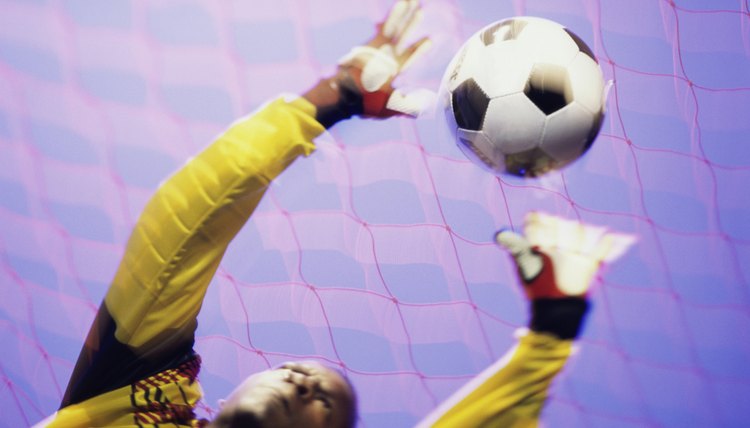Rules for Goalkeeper in Soccer

As a soccer goalie, you must adhere to most of the same fundamental rules as the rest of the players. There are certain rules that apply only to goalkeepers, most of which relate to the fact that you are able to handle the ball with your hands inside the penalty box, whereas field players are not. You also must abide by certain equipment rules if the team or league you play in follows the Federation Internationale de Football Association, or FIFA regulations.
Equipment
According to FIFA's Laws of the Game, a goalie must wear a different color uniform that distinguishes you from the rest of your team, as well as the opposing team and referees. Just like field players, goalies must wear appropriate stockings, shin guards and soccer cleats. Jewelry is not allowed.
Ball Handling
As a goalkeeper, you are allowed to handle the ball with your hands within your penalty area. You can catch any ball that is shot, headed or passed by the opposing team within this area. You also can handle the ball after it has touched one of your teammates, as long as the ball was not deliberately passed to you. In some cases, it is unclear if the ball is passed, at which point the referee makes a judgment call. If a teammate passes the ball, you must dribble the ball first and gain control. Only thereafter can you pick up the ball. You may not handle a ball from a teammate's throw-in; but a ball that is headed to you by a teammate can be handled. You can distribute the ball back into play after gaining control of it by throwing or kicking it. If you throw the ball and it remains in the penalty area, you cannot handle the ball again. You have six seconds to distribute the ball from the moment you gain control. If you deliberately take more time, you may receive a verbal warning from the referee and a yellow card caution on subsequent infractions.
Goal Kicks
When the ball is kicked out of bounds past the goal line by the opposing team, a goal kick is awarded to your team. In general, the goalie takes the goal kick but is not required to. If you take the goal kick, you can place the ball anywhere along the 6-yard box line -- the smaller box inside of the penalty area. Once the ball is kicked, if it by chance remains inside of the penalty area, you are not allowed to handle it.
Fouls
Though goalkeepers receive a little more leeway from referees when defending, a goalie can commit a foul just like field players. If you intentionally impede an attacker from moving about the pitch, either by tripping, pushing or pulling on his jersey, a referee can call you for a foul. If the foul occurs within the penalty area, you may receive a yellow or red card, depending on the severity of the foul. If a foul is given within the penalty area, a penalty kick is awarded to the opposing team.
Field Play
Goalies are allowed to come out of their penalty area and participate in field play. Once you leave your penalty area, you are no longer allowed to handle the ball. Certain game situations lend themselves to the goalie leaving his penalty area. This is common during close game situations when a goal is needed to tie or win the game. One instance you might come out of your penalty area to support the rest of your team in the opposing team's penalty area is during a corner kick.
Penalty Kicks
You must remain on the goal line between the goal posts before the ball is kicked during a penalty kick. Once the ball is kicked, you can move your body forward in an effort to cut down the shooting angle. As a goalie, you also may take penalty kicks if one is awarded to your team.
References
Writer Bio
Dan Harriman began writing professionally in 2009 and has a varied background in marketing, ranging from sports management to music promotion. Harriman holds a Bachelor of Science in journalism with an emphasis on strategic communications from the University of Kansas and earned the International Advertising Association's diploma in marketing communications.
